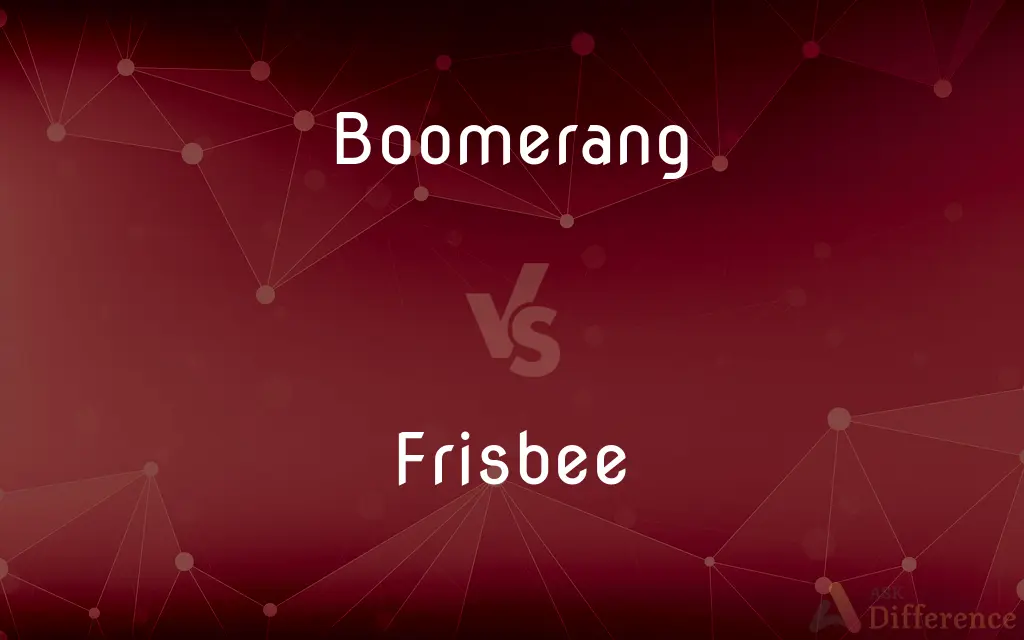Boomerang vs. Frisbee — What's the Difference?
By Maham Liaqat & Urooj Arif — Updated on March 7, 2024
A boomerang is a curved, flat tool designed to return to the thrower, traditionally used by Indigenous Australians for hunting, while a Frisbee is a disc-shaped gliding toy or sporting item, popular for recreational use and sports like Ultimate Frisbee.

Difference Between Boomerang and Frisbee
Table of Contents
ADVERTISEMENT
Key Differences
The boomerang and the Frisbee are both flying objects, but they serve different purposes and have distinct flight paths. The boomerang, with its unique curved shape, is engineered to fly in an elliptical path, allowing it to return to the thrower. This characteristic made it an effective tool for hunting by Indigenous Australians, who mastered the art of boomerang throwing for various uses, including hunting and sport. The Frisbee, on the other hand, is a circular disc designed for straight, stable flight paths. It is used worldwide for casual play in parks and beaches, as well as in organized sports like Ultimate Frisbee and disc golf.
Boomerangs are made from a variety of materials, including wood, bone, and modern plastics, and they require a specific throwing technique to achieve the returning flight. Frisbees are primarily made from plastic and are thrown by giving them a spin, which stabilizes their flight due to the gyroscopic effect. The ease of use and the social aspect of throwing a Frisbee make it a popular choice for group activities.
The design of a boomerang is rooted in aerodynamic principles that exploit the lift generated by its curved arms, enabling it to travel in a curved path and return. Frisbees rely on aerodynamic lift as well, but their shape and throwing technique result in a linear flight path intended for catch games or precision sports, rather than return to the thrower.
The boomerang holds significant historical and cultural value for Indigenous Australians, symbolizing one of the earliest uses of aerodynamics for toolmaking. The Frisbee, while lacking ancient historical roots, has developed a culture of its own since its popularization in the mid-20th century, leading to the creation of numerous sports and recreational activities centered around its use.
Boomerangs and Frisbees are affected differently by environmental factors such as wind. A skilled boomerang thrower can use the wind to control the flight path and ensure the return of the boomerang, while Frisbee players must adapt their throwing technique to maintain accuracy and stability in windy conditions.
ADVERTISEMENT
Comparison Chart
Shape
Curved, with a distinct angle
Circular disc
Purpose
Hunting, sport, return to thrower
Recreation, sports like Ultimate and disc golf
Material
Wood, bone, modern plastics
Mainly plastic
Flight Path
Elliptical, designed to return
Straight, stable, does not return
Origin
Indigenous Australians
Mid-20th century America
Cultural Significance
Historical tool and sport
Recreational toy, sports equipment
Throwing Technique
Specific technique for return
Spin for stability
Aerodynamics
Exploits lift for curved return path
Uses lift for linear flight
Environmental Adaptability
Uses wind for flight control
Adjust throwing technique in wind
Compare with Definitions
Boomerang
Traditionally used by Indigenous Australians for hunting.
Indigenous Australians crafted boomerangs from wood for hunting.
Frisbee
Made primarily from plastic for stability.
The plastic Frisbee glides smoothly through the air.
Boomerang
Requires a specific throwing technique.
Mastering the boomerang's return requires practice and technique.
Frisbee
Popularized for recreational use worldwide.
Frisbee became a symbol of outdoor fun in the 20th century.
Boomerang
Can be made from various materials.
Modern boomerangs are often made from lightweight plastics.
Frisbee
Used in sports like Ultimate Frisbee and disc golf.
Ultimate Frisbee teams compete in fast-paced games in parks.
Boomerang
Symbolizes early aerodynamic toolmaking.
The boomerang is an ancient example of human ingenuity in aerodynamics.
Frisbee
A disc-shaped toy for throwing and catching.
They enjoyed throwing the Frisbee at the beach.
Boomerang
A curved tool designed to return to the thrower.
He skillfully threw the boomerang, watching it return to his hand.
Frisbee
Thrown with a spin for linear flight.
A good Frisbee throw requires a steady spin for stability.
Boomerang
A boomerang is a thrown tool, typically constructed as a flat airfoil, that is designed to spin about an axis perpendicular to the direction of its flight. A returning boomerang is designed to return to the thrower.
Frisbee
A flying disc (also called a Frisbee or simply a disc) is a gliding toy or sporting item that is generally made of injection-molded plastic and roughly 8 to 10 inches (20 to 25 cm) in diameter with a pronounced lip. It is used recreationally and competitively for throwing and catching, as in flying disc games.
Boomerang
A flat, curved, usually wooden missile configured so that when hurled it returns to the thrower.
Frisbee
(countable) Frisbee {{q}}
Boomerang
A statement or course of action that backfires.
Frisbee
Alternative form of Frisbee}} {{q
Boomerang
To have the opposite effect from the one intended; backfire.
Frisbee
Alternative form of Frisbee
Boomerang
A flat curved airfoil that spins about an axis perpendicular to the direction of flight, originally used in various parts of the world as a hunting weapon or, in returnable types, for sports or training.
Frisbee
A light plastic disk about 10 inches in diameter; sailed with a flip of the wrist for recreation or competition
Boomerang
A breakdancing move in which the performer walks on their hands while keeping the legs raised off the ground.
Boomerang
A boomerang kick.
Boomerang
(theatre) A device for changing the color of a followspot.
Boomerang
Slang}} An early return of an aircraft whose mission was aborted, often due to technical failures.
Boomerang
(intransitive) To return or rebound unexpectedly, especially when the result is undesired; to backfire.
Boomerang
(intransitive) To travel in a curved path.
Boomerang
Slang}} To abort a mission and return to base early.
Boomerang
A very singular missile weapon used by the natives of Australia and in some parts of India. It is usually a curved stick of hard wood, from twenty to thirty inches in length, from two to three inches wide, and half or three quarters of an inch thick. When thrown from the hand with a quick rotary motion, it describes very remarkable curves, according to the shape of the instrument and the manner of throwing it, often moving nearly horizontally a long distance, then curving upward to a considerable height, and finally taking a retrograde direction, so as to fall near the place from which it was thrown, or even far in the rear of it.
Boomerang
A curved piece of wood; when properly thrown will return to thrower
Boomerang
A miscalculation that recoils on its maker
Boomerang
Return to the initial position from where it came; like a boomerang
Common Curiosities
How important is the throwing technique for boomerangs and Frisbees?
Both require specific techniques; boomerangs for the returning flight path and Frisbees for stability and accuracy in linear flight.
Can anyone learn to throw a boomerang or Frisbee?
Yes, with practice, anyone can learn the proper technique to throw both boomerangs and Frisbees effectively.
What distinguishes a boomerang's flight from a Frisbee's?
A boomerang is designed to fly in a curved path and return to the thrower, while a Frisbee flies in a straight path and does not return.
Can a Frisbee be used for hunting like a boomerang?
No, Frisbees are designed for recreational and sport purposes, not for hunting.
What makes a Frisbee stable in flight?
The spin given to a Frisbee during its throw creates a gyroscopic effect, stabilizing its flight.
Is there competitive sport involving boomerangs?
Yes, there are competitive sports and events focused on boomerang throwing, emphasizing accuracy, distance, and the return.
Are boomerangs still used by Indigenous Australians today?
Yes, boomerangs are still used for cultural purposes, sport, and art by Indigenous Australians.
How do wind conditions affect the flight of boomerangs and Frisbees?
Boomerangs can use wind to aid their returning flight, while Frisbee players must adjust their throws for accuracy in windy conditions.
Why do boomerangs return to the thrower?
Boomerangs return due to their curved shape and the aerodynamic lift generated, allowing them to travel in an elliptical path.
How did the Frisbee get its name?
The name "Frisbee" was inspired by the Frisbie Pie Company, whose pie tins were thrown and caught in a similar manner to the discs.
Share Your Discovery

Previous Comparison
Preposition vs. Coverb
Next Comparison
Purchaser vs. VendeeAuthor Spotlight
Written by
Maham LiaqatCo-written by
Urooj ArifUrooj is a skilled content writer at Ask Difference, known for her exceptional ability to simplify complex topics into engaging and informative content. With a passion for research and a flair for clear, concise writing, she consistently delivers articles that resonate with our diverse audience.















































